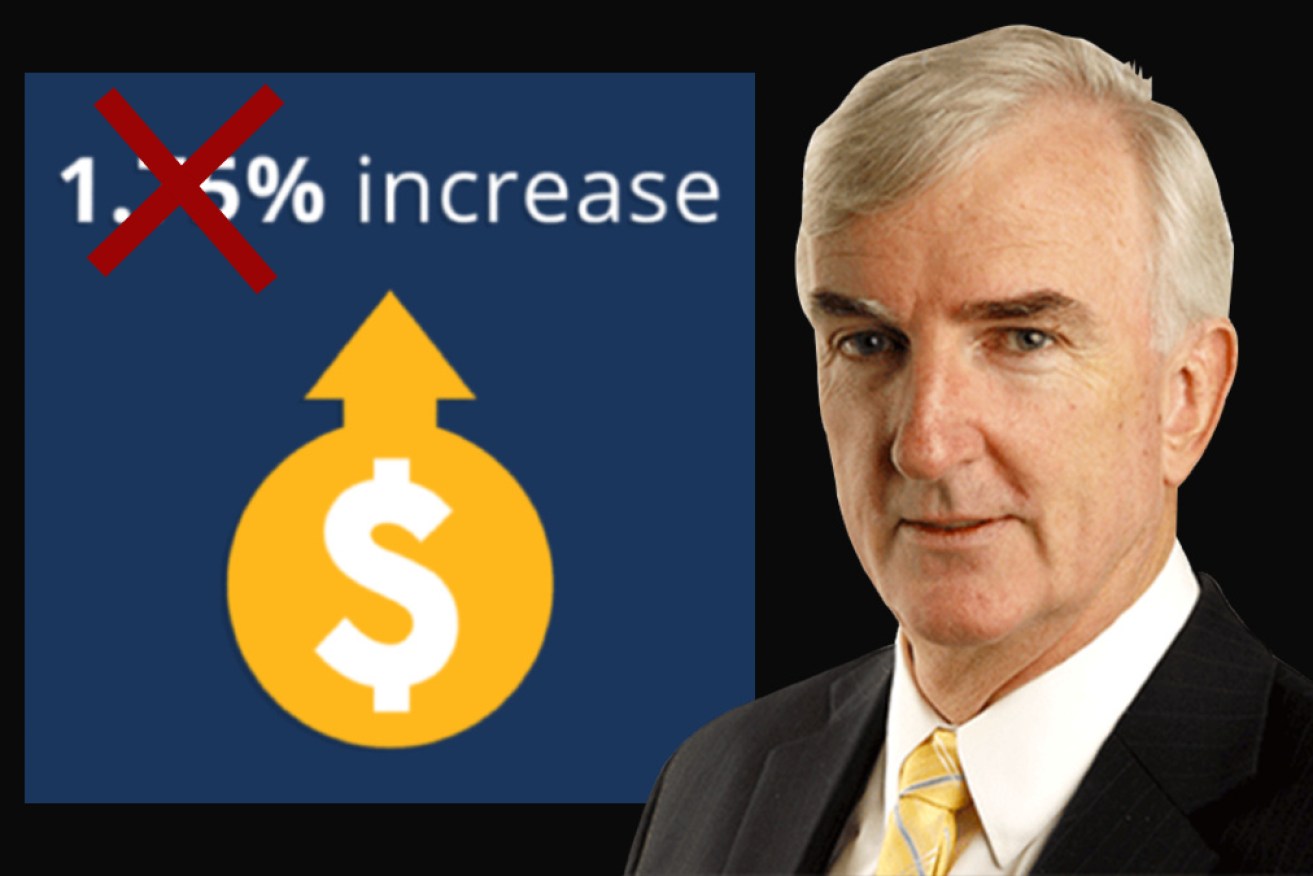Michael Pascoe: No, the minimum wage is not rising by 1.75 per cent


The minimum wage rise is actually a pay cut. Photo: TND
The headlines last week declared that the Fair Work Commission had granted a 1.75 per cent increase in the minimum wage, an increase that flows on to numerous awards.
It didn’t really.
The actual increase will be 1.4 per cent when it finally arrives – $9.30 a week, not even $2 a day.
And in industries most affected by COVID-19, that won’t be until February next year.
The 1.4 per cent increase compares with the consumer price index jumping by 2.2 per cent in the year to the end of March and the “trimmed mean” measure of underlying inflation rising by 1.8 per cent.
Those CPI and trimmed mean figures were the inflation measures included in the FWC national minimum wage summary.
Yes, the minimum wage is shrinking in real terms.
The difference between the 1.75 per cent headline and the 1.4 per cent reality is the income tax system, even with the low and low-to-middle income tax offsets.
To actually achieve an after-tax increase of 1.75 per cent – close to that 1.8 per cent trimmed mean inflation rate – the pre-tax pay rise would have to be 2.2 per cent.*
Yet the FWC majority decision states:
“We acknowledge that any increase we award which is less than increases in prices and living costs would amount to a real wage cut. Such an outcome would mean that many award-reliant employees, particularly low-paid employees, would be less able to meet their needs. For some households such an outcome would lead to further disadvantage and may place them at greater risk of moving into poverty.”
The commission had to weigh the conflicting arguments of employers wanting no wage rise at all, the ACTU seeking a 4 per cent increase, and the federal government asking it to “take a cautious approach in light of the continuously emerging and wide-ranging potential impacts of the COVID-19 pandemic and to prioritise keeping Australians in jobs and maintaining the viability of businesses”.
It also faced the macroeconomic dilemma of the nation needing people to be able to spend to get out of recession while some individual businesses struggle to stay afloat because of the recession – billed as a trade-off for businesses being able to pay workers more per hour or offer them more hours.
And, by the nature of one-size-fits-all awards, there are some enterprises that have been doing well through the crisis or have not been affected by it, but have now been given a licence to effectively reduce their employees’ real wages.
The relatively junior salaried staff covered by the Reserve Bank of Australia Award can only expect a 1.75 per cent pre-tax rise although the RBA is set to make fat profits from the interest on all the bonds it is buying.
Some small retailers will not reopen and many will struggle, but Bunnings, JB Hi-Fi, Harvey Norman and the big supermarkets have been performing strongly. And the biggest problem for retail pre-COVID was weak consumption caused by sub-par wage increases.
While international tourism operators have lost their business, the big West Australian miners – BHP, Rio, Fortescue and Gina Rinehart – are absolutely booming, the dollars gushing in from high iron ore prices.
The Australian dollar gold price is none too shabby, either.
(And if those companies aren’t granting substantial pay rises and/or fat bonuses in these times, they’re not part of the alleged “Team Australia”. Their track record over the past decade, though, is to try to squeeze every last cent out of their suppliers and sub-contractors, never mind Ms Rinehart warning of African workers getting $2 a day.

Some retailers are booming, but they won’t have to pay higher minimum wages.
In reaching its decision to grant an increase actually below the recorded inflation rate, the FWC was relying on the federal government’s tax-transfer system to make up the difference:
“We have decided to award a substantially lower increase this year than that awarded last year due to the marked change in the economic environment and the tax-transfer system and other changes which have taken effect in the current Review period which have benefitted low-paid households.
“The increases we have awarded are likely to maintain the real value of the wages of NMW and award-reliant employees.”
The Fair Work commissioners, people very well paid to understand all aspects of wages, seem to have an inflated idea of the tax-transfer system’s beneficence.
Yes, there’s a $750 tax-free payment next month for pensioners and those receiving family tax benefits – but nothing for workers without children.
Using the icalculator.info Australian salary calculator, the low and low-to-middle income tax rebates aren’t enough to maintain real wages for those on the minimum or median wage.
Adding 1.75 per cent to the median wage ends up a fraction under 1.4 per cent after tax.
Somewhat oddly, the FWC cites the temporary JobSeeker supplement and JobKeeper as factors.
As far as we know, both are gone in three months and JobSeeker doesn’t apply to someone working.
And the keep-it-simple icalculator.info examples don’t get into the labyrinthine interactions between the social security system and wage earners that can be extremely costly with effective tax rates of more than 90 per cent.
Tweet from @MichaelPascoe01
Deep in the body of the FWC’s full 159-page decision, there is this observation:
“We also affirm the Panel’s previously expressed view that the tax-transfer system can provide a more targeted and efficient approach to addressing poverty among low-income individuals, increasing low-paid households’ disposable incomes and sustaining their relative living standards.
“However, while minimum wage increases are not fully reflected in household disposable income, minimum wages continue to play a large role in improving household income for low-income minimum wage families.”
In his dissenting minority decision, Professor Mark Wooden wanted no wage increase. He at least acknowledged there wasn’t much in the majority verdict for workers:
“A zero change to the minimum wage will do little damage to workers. It is very unlikely that it is going to tip any additional households into poverty.
“In contrast, a small increase in award wages will add very little to a worker’s disposable household income, while at the same time reducing the likelihood of existing businesses returning to pre-recession levels of employment and labour utilisation, and of new employing businesses commencing operation.”
The full decision recorded last month’s RBA inflation forecasts – a “brave” 2.75 per cent CPI increase for the year ending June 2020, with the trimmed mean expected to rise 1.25 per cent.
The RBA hasn’t had much luck in the forecasting business lately.
The bank says the main factor determining the inflation rate will be the deflationary effects of spare capacity in the labour market and the economy more generally.
In other words, high unemployment and underemployment will keep wages – and therefore inflation – down.
Wage freezes, wage cuts and small wage rises – understandable for businesses on the edge of collapse, yet in their way contributing to keeping businesses on the edge of collapse.
Those on the minimum wage receiving less than an extra $2 a day in their pocket might yet maintain their existing living standard because of deflationary pressures – but that would pose another set of economic problems.
The solution, alluded to by the FWC, is in the hands of the government, as is the opportunity for serious employment creation initiatives in the new financial year.
What we’ve heard of post-September policy so far though is to do little, primarily relying on “market forces”.
*Note: Using an online tax calculator, the present minimum wage of $38,625 a year ($740.80 a week) turns into take-home pay of $34,741 after taking into account income tax, Medicare and both the low-income tax offset and the low-to-middle income tax offset.
The new minimum wage of $39,303 ($753.80 a week) results in take-home pay of $35,226 – an increase of $485, or 1.4 per cent.
It would require a pre-tax increase of 2.2 per cent to deliver take-home pay of $35,349 – an increase of 1.75 per cent.








